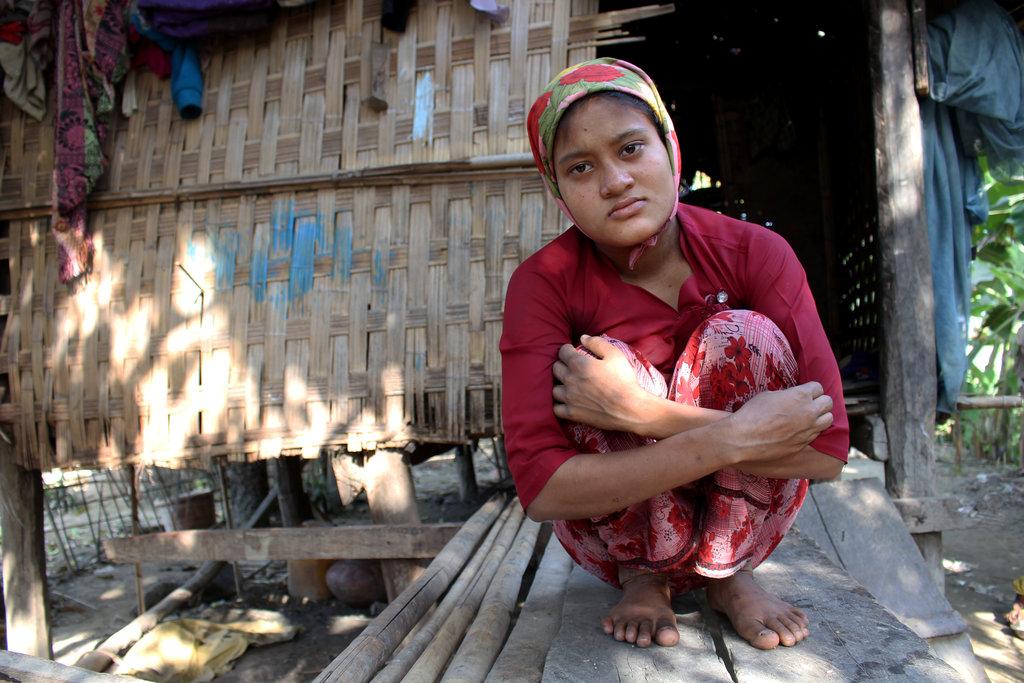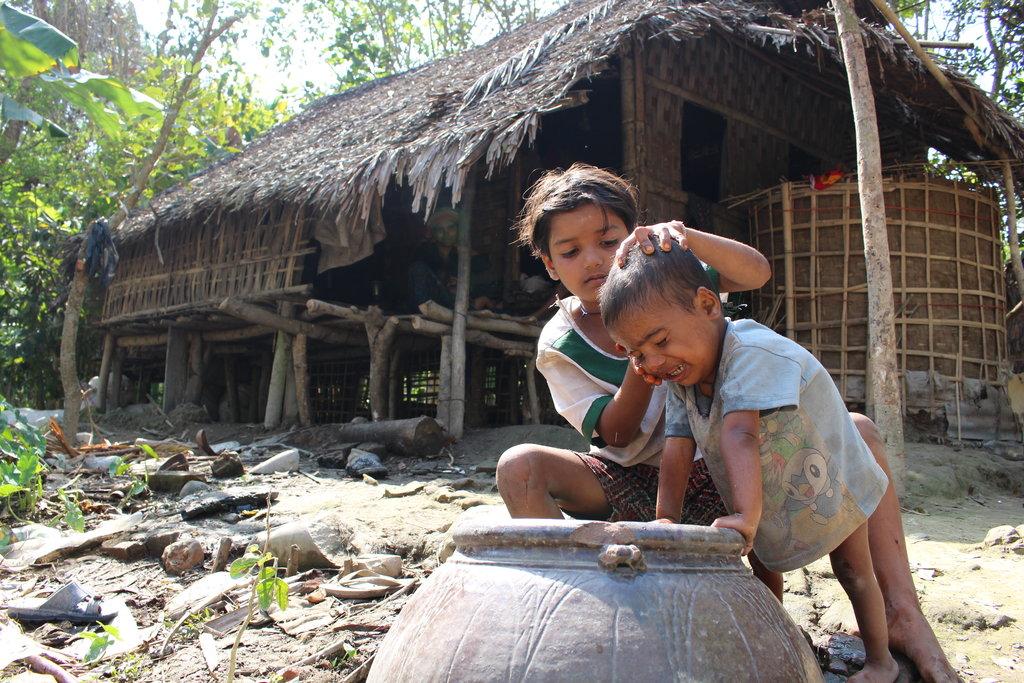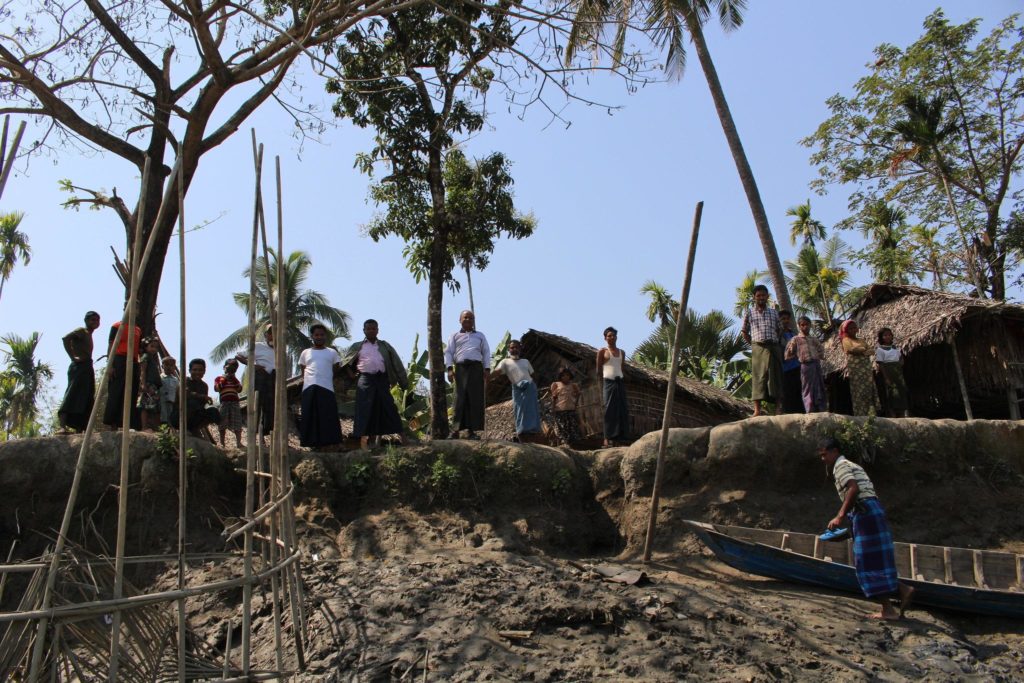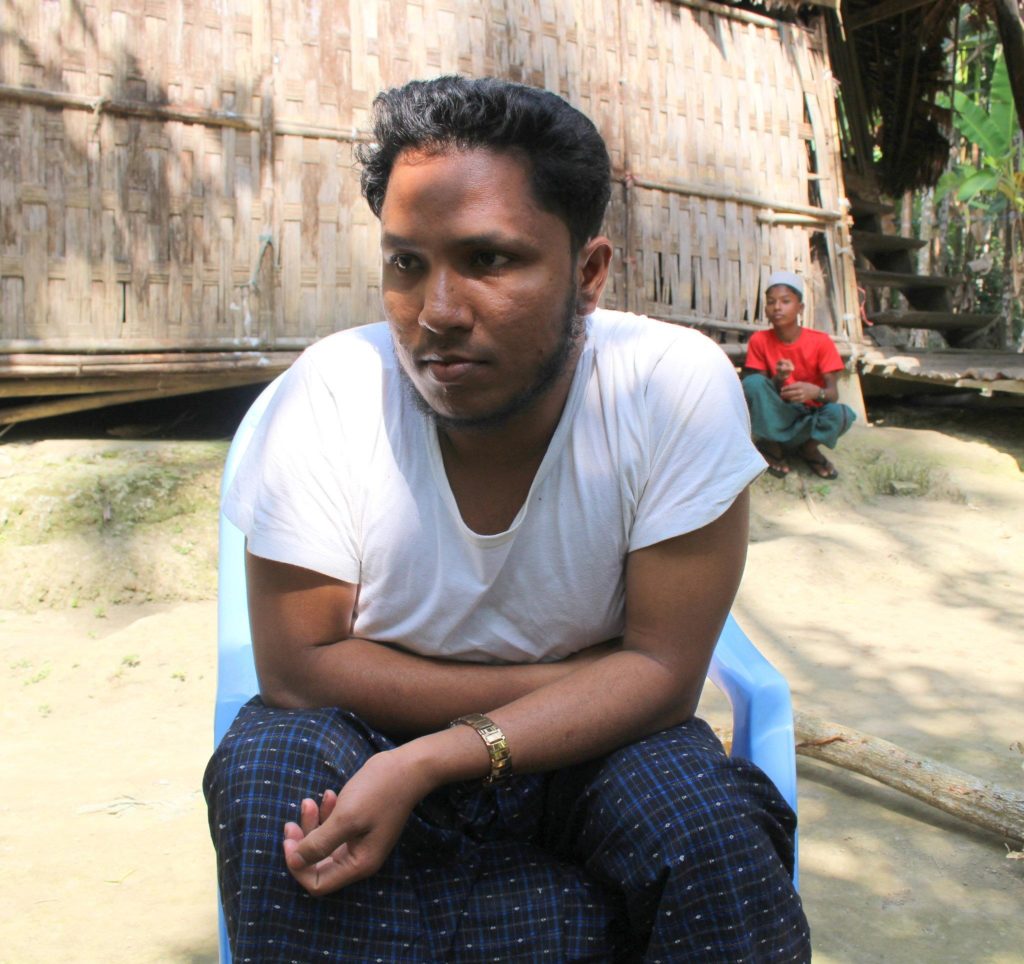I Saw a Genocide in Slow Motion in Burma/Myanmar
ASIA--PACIFIC, 12 Mar 2018
Nicholas Kristof – The New York Times

Sono Wara, a Rohingya in her village in Myanmar a day after the death of her newborn twins. CreditNicholas Kristof/The New York Times
2 Mar 2018 — Sono Wara spent the day crying. And even after her tear ducts emptied, her shirt was still wet from leaking milk.
Her newborn twins had died the previous day, and she squatted in her grass-roof hut, shattered by pain and grief. She is 18 and this was her first pregnancy, but as a member of the Rohingya ethnic minority she could not get a doctor’s help. So after a difficult delivery, her twins lie buried in the ground.
Sometimes Myanmar uses guns and machetes for ethnic cleansing, and that’s how Sono Wara earlier lost her mother and sister. But it also kills more subtly and secretly by regularly denying medical care and blocking humanitarian aid to Rohingya, and that’s why her twins are gone.
Myanmar and its Nobel Peace Prize-winning leader, Aung San Suu Kyi, are trying to make the Rohingya’s lives unlivable, while keeping out witnesses. Some 700,000 Rohingya have fled to Bangladesh in recent months, but the fate of those left behind has been less clear, for Myanmar mostly bans foreigners from Rohingya areas. The government fired a warning flare when it arrested two Reuters journalists for reporting on an army massacre of Rohingya; the reporters face up to 14 years in prison for committing superb journalism.
Entering Myanmar on a tourist visa, I was able to slip undetected into five Rohingya villages. What I found was a slow-motion genocide. The massacres and machete attacks of last August are over for now, but Rohingya remain confined to their villages — and to a huge concentration camp — and are systematically denied most education and medical care.
So they die. No one counts the deaths accurately, but my sense is that the Myanmar government kills more Rohingya by denying them health care and sometimes food than by wielding machetes or firing bullets.
This is my fourth trip in four years to cover the Rohingya, a Muslim minority despised in a mostly Buddhist country, and initially I used the term “ethnic cleansing.” But along with many human rights monitors, I’ve come to conclude that what is unfolding here probably qualifies as genocide.

Umar Amin being bathed by his older sister. He is 4 years old but stunted and unable to walk because of malnutrition.
CreditNicholas Kristof/The New York Times
Scholars at Yale University and the U.S. Holocaust Museum have already warned that this may be genocide, as has the United Nations human rights chief, Zeid Ra’ad al-Hussein. This genocide sometimes consists of violent attacks, but now mostly of denying food or medical care.
“These tactics are right out of the genocidaires’ playbook,” said Matthew Smith of Fortify Rights, a human rights group specializing in Myanmar, also called Burma. “Underfeeding and systematically weakening a population has been characteristic of other genocides.”
Sono Wara was unable to receive any prenatal or emergency care. In a crisis, a Rohingya can request police permission to go to a government clinic down the road that serves the general population, but it lacks a doctor, and Rohingya are often fearful of being attacked. They also must pay for a police escort at the clinic, adding to the cost.
“I was afraid to go,” Sono Wara said in a catatonic voice. “The clinic doesn’t care about Rohingya.”
On top of her physical and emotional pain is a constant fear. Her village wasn’t attacked in the August wave of violence, but, Sona Wara said, “That could happen here.” In 2012, people from a nearby village attacked with machetes and killed her mother and sister.
One theory is that Myanmar is trying to create such misery and fear that the Rohingya will flee on their own, so that the army doesn’t need to bother with the messy business of massacres. Sono Wara said that she and her husband have discussed trying to escape to Malaysia — a perilous journey that often involves rape, robbery and death.
Myanmar’s ethnic cleansing became impossible to hide with the exodus in August of Rohingya bearing stories of massacres and pogroms. In interviewing those refugees late last year, I was particularly shaken by the account of a woman, Hasina Begum, who told me how soldiers had executed the men and boys in her village, had made a bonfire of their bodies and had then taken the women to a hut to be raped. “I was trying to hide my baby under my scarf, but they saw her leg,” Hasina Begum said. “They grabbed my baby by the leg and threw her onto the fire.”

A small Rohingya village in Myanmar. Residents are confined there, not usually allowed to leave to hold jobs, attend school or receive medical care.
CreditNicholas Kristof/The New York Times
What’s happening to those left behind in the villages is a more banal kind of brutality. In one remote hamlet reachable only by boat or footpath, I saw a stunted 4-year-old, Umar Amin, being bathed by his big sister.
I pulled out a MUAC strip, used to assess child malnutrition by measuring the upper arm, and Umar Amin was in the red danger zone, signifying severe acute malnutrition. He can’t walk or talk and desperately needs help, but he has never been able to see a doctor.
International aid groups are ready and eager to help children like Umar Amin, but the government often blocks them, especially in northern areas near the Bangladesh border. It is difficult to understand this denial of humanitarian access as anything but an intentional policy of grinding down and driving out the Rohingya — one reason I see this as a slow-motion genocide.
What of “The Lady,” Aung San Suu Kyi, who won her Nobel for her resolute struggle for the human rights of Myanmar? She is now the effective leader of Myanmar’s government and has emerged as not only an apologist for this genocide, but also as complicit in it.
Suu Kyi does not control the army, which committed the massacres, but she has helped keep aid groups away. She has also tried to erase the existence of the Rohingya, rejecting the term and saying that they are merely illegal immigrants from Bangladesh. (In fact, a document from 1799 shows the Rohingya were well established here even then.) And it is her government that is proceeding with the criminal case against the two Reuters reporters.
I was able to get a tourist visa because I was leading a segment of a tour sponsored by The New York Times Company to Myanmar. The visa came with a stern warning that I must not do any reporting. In general, I believe that journalists should obey the laws of countries they visit, but I make an exception when a regime uses its laws to commit and hide crimes against humanity.
In one case on this trip, I arrived after dark so I would be less likely to be spotted. In others, villagers advised me on what paths to take to avoid the police. To get to two villages, I took a boat around a police checkpoint.
In one of the villages reached by boat, I met Zainul Abedin as he mourned his wife, Jahan Aara, 20, who had died in childbirth, along with their baby. It was her first pregnancy, and she got no medical help.
“Maybe she would have died even in a hospital, but at least she would have had a chance,” Zainul Abedin said. “This way she didn’t even have a chance.”
He is thinking of trying to escape, which would entail paying human traffickers $2,300 to smuggle him to Malaysia. The authorities hound aid workers and journalists, but they seem to look the other way from these human traffickers.
Many of those who set out die en route. Zainul Abedin knows the risks because his own father fled in hopes of reaching Malaysia and hasn’t been heard from since.
“We are like a bird in a cage,” Zainul Abedin told me. “They give us less and less, we get smaller and smaller, and then we die. Or we can try to flee, and then they can kill us.”
The Rohingya have been confined to their villages and the concentration camp for almost six years now, with restrictions tightened further after the August massacres. Elders complained to me in particular about the loss of education, as Rohingya aren’t allowed to attend regular schools. Villages try to run informal schools of their own, but without textbooks, desks and proper teachers, not much learning happens, and even the most brilliant children have no hope of ever attending high school or a university. The result is a lost generation.
Many Myanmar readers will find my reporting unfair, for their narrative is very different. Htun Aung Kyaw, a leader of the Arakan National Party, the main political party here in Rakhine State, told me the key points as he sees them: The Rohingya are illegal immigrants, they have been trying for decades to create a separate Islamic state, they include armed insurgents who commit atrocities, and they burn their own villages so as to discredit the Myanmar government.

Zainul Abedin mourned his wife, who died in childbirth in the home behind him. She was not allowed to deliver in a hospital.
CreditNicholas Kristof/The New York Times
That is mostly nonsense, although it’s quite true that a Rohingya rebel group precipitated the August violence with attacks on police stations. The army responded with scorched-earth tactics that, by the count of Doctors Without Borders, resulted in at least 9,000 Rohingya deaths. The army has for decades waged ferocious counterinsurgencies against other ethnic minorities, such as the Shan and Karen, so raping and murdering civilians may have reflected not so much military strategy as muscle memory.
Ordinary citizens often seem to have been manipulated by anti-Rohingya propaganda, particularly on Facebook. One moderate Rakhine village leader, U Maung Kyaw Nyunt, told me that the hatred toward the Rohingya has escalated because of the arrival of smartphones and Facebook, resulting in virulent anti-Rohingya propaganda depicting them as murderous terrorists who commit atrocities against Buddhists.
“Young people are using their smartphones a lot,” he said. “They don’t see with their eyes; they just see with their phones.”
“I have arguments with my son about this,” he said, adding, “Facebook has been bad for Myanmar.”
The military has internet units trained by Russia, and one theory is that the army may be behind part of the social media campaign against the Rohingya.
The West doesn’t have much leverage over Myanmar, and China protects it on the United Nations Security Council. David Mathieson, a longtime human rights analyst in Myanmar, said that outside protests about the Rohingya have been largely ineffective, and sometimes counterproductive, as when exaggerations play into the Myanmar narrative of victimhood.
Still, we can work with other countries to raise the cost of ethnic cleansing, and under international law we have an obligation to take steps to address genocide (although the law does not stipulate that these actions must be particularly significant). A crucial first step is targeted sanctions against Myanmar leaders, as bipartisan legislation in both the House and the Senate proposes. The bill passed the Senate Foreign Relations Committee but needs approval from the Senate Republican leadership to go forward.
The U.S. government can also do more to name and shame the perpetrators, and to exert relentless pressure for humanitarian access. It was good to see Nikki Haley, the U.S. ambassador to the United Nations, denounce Myanmar last month for making life for the Rohingya “a death sentence.” We can ask the intelligence community to gather evidence of war crimes. Through Voice of America, we could broadcast lessons for Rohingya schools.
The suffering in these Rohingya villages is easy to ignore at a time of global and domestic upheaval. We all suffer distraction and compassion fatigue. But as Elie Wiesel, the great survivor of a different genocide, said in his Nobel Peace Prize acceptance speech, “Wherever men or women are persecuted because of their race, religion or political views, that place must — at that moment — become the center of the universe.”
By that standard, the grass-roof hut where Sona Wara weeps over her lost twins cries out to us as a center of the universe.
THIS IS A VIDEO I did about the Rohingya in 2014.
__________________________________________________
 Nicholas Kristof, a columnist for The New York Times since 2001, writes op-ed columns that appear twice a week. Mr. Kristof won the Pulitzer Prize two times, in 1990 and 2006. In 2012, he was a Pulitzer finalist in Commentary for his 2011 columns that often focused on the disenfranchised in many parts of the world.
Nicholas Kristof, a columnist for The New York Times since 2001, writes op-ed columns that appear twice a week. Mr. Kristof won the Pulitzer Prize two times, in 1990 and 2006. In 2012, he was a Pulitzer finalist in Commentary for his 2011 columns that often focused on the disenfranchised in many parts of the world.
A version of this article appears in print on March 4, 2018, on Page SR1 of the New York edition with the headline: I Saw a Genocide in Slow Motion.
DISCLAIMER: The statements, views and opinions expressed in pieces republished here are solely those of the authors and do not necessarily represent those of TMS. In accordance with title 17 U.S.C. section 107, this material is distributed without profit to those who have expressed a prior interest in receiving the included information for research and educational purposes. TMS has no affiliation whatsoever with the originator of this article nor is TMS endorsed or sponsored by the originator. “GO TO ORIGINAL” links are provided as a convenience to our readers and allow for verification of authenticity. However, as originating pages are often updated by their originating host sites, the versions posted may not match the versions our readers view when clicking the “GO TO ORIGINAL” links. This site contains copyrighted material the use of which has not always been specifically authorized by the copyright owner. We are making such material available in our efforts to advance understanding of environmental, political, human rights, economic, democracy, scientific, and social justice issues, etc. We believe this constitutes a ‘fair use’ of any such copyrighted material as provided for in section 107 of the US Copyright Law. In accordance with Title 17 U.S.C. Section 107, the material on this site is distributed without profit to those who have expressed a prior interest in receiving the included information for research and educational purposes. For more information go to: http://www.law.cornell.edu/uscode/17/107.shtml. If you wish to use copyrighted material from this site for purposes of your own that go beyond ‘fair use’, you must obtain permission from the copyright owner.